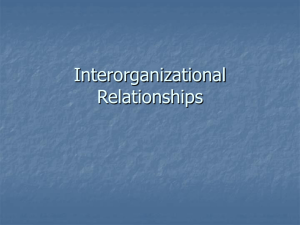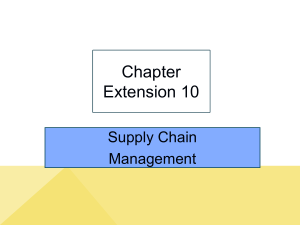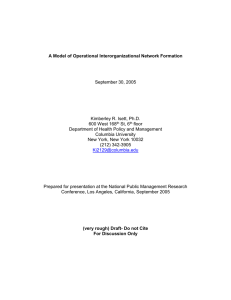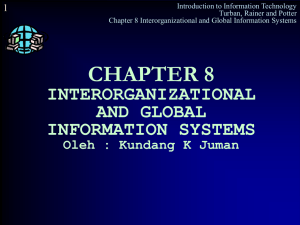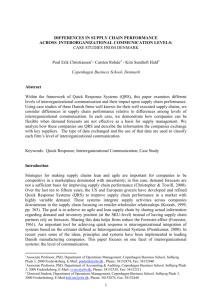Conceptual Definition of Interorganizational Collaboration and
advertisement
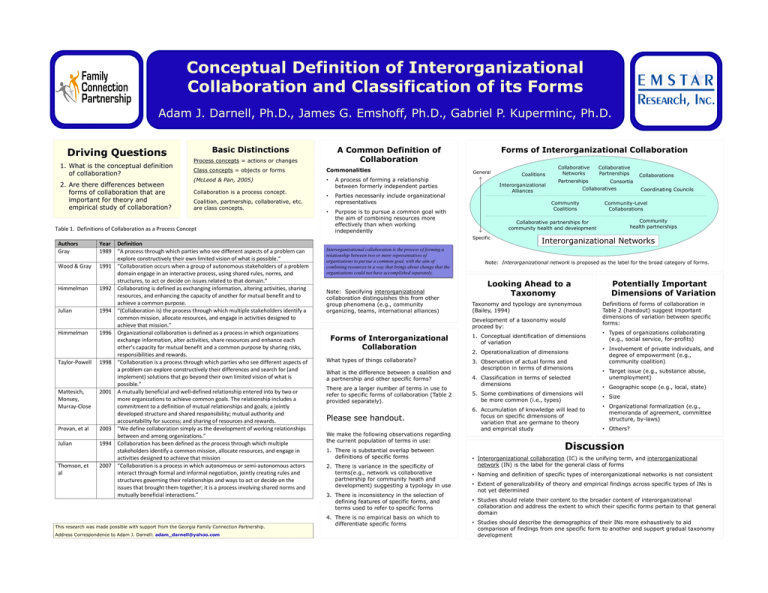
Conceptual Definition of Interorganizational Collaboration and Classification of its Forms Adam J. Darnell, Ph.D., James G. Emshoff, Ph.D., Gabriel P. Kuperminc, Ph.D. Driving Questions 1. What is the conceptual definition of collaboration? 2. Are there differences between forms of collaboration that are important for theory and empirical study of collaboration? Basic Distinctions Process concepts = actions or changes Class concepts = objects or forms Commonalities (McLeod & Pan, 2005) • Collaboration is a process concept. Coalition, partnership, collaborative, etc. are class concepts. Table 1. Definitions of Collaboration as a Process Concept Forms of Interorganizational Collaboration A Common Definition of Collaboration • • General A process of forming a relationship between formerly independent parties Interorganizational Alliances Parties necessarily include organizational representatives Purpose is to pursue a common goal with the aim of combining resources more effectively than when working independently Wood & Gray Himmelman Julian Himmelman Taylor-Powell Mattesich, Monsey, Murray-Close Provan, et al Julian Thomson, et al Year Definition 1989 “A process through which parties who see different aspects of a problem can explore constructively their own limited vision of what is possible.“ 1991 “Collaboration occurs when a group of autonomous stakeholders of a problem domain engage in an interactive process, using shared rules, norms, and structures, to act or decide on issues related to that domain.” 1992 Collaborating is defined as exchanging information, altering activities, sharing resources, and enhancing the capacity of another for mutual benefit and to achieve a common purpose. 1994 “(Collaboration is) the process through which multiple stakeholders identify a common mission, allocate resources, and engage in activities designed to achieve that mission.” 1996 Organizational collaboration is defined as a process in which organizations exchange information, alter activities, share resources and enhance each other’s capacity for mutual benefit and a common purpose by sharing risks, responsibilities and rewards. 1998 “Collaboration is a process through which parties who see different aspects of a problem can explore constructively their differences and search for (and implement) solutions that go beyond their own limited vision of what is possible.” 2001 A mutually beneficial and well-defined relationship entered into by two or more organizations to achieve common goals. The relationship includes a commitment to a definition of mutual relationships and goals; a jointly developed structure and shared responsibility; mutual authority and accountability for success; and sharing of resources and rewards. 2003 “We define collaboration simply as the development of working relationships between and among organizations.” 1994 Collaboration has been defined as the process through which multiple stakeholders identify a common mission, allocate resources, and engage in activities designed to achieve that mission 2007 “Collaboration is a process in which autonomous or semi-autonomous actors interact through formal and informal negotiation, jointly creating rules and structures governing their relationships and ways to act or decide on the issues that brought them together; it is a process involving shared norms and mutually beneficial interactions.” This research was made possible with support from the Georgia Family Connection Partnership. Address Correspondence to Adam J. Darnell: adam_darnell@yahoo.com Interorganizational collaboration is the process of forming a relationship between two or more representatives of organizations to pursue a common goal, with the aim of combining resources in a way that brings about change that the organizations could not have accomplished separately. Note: Specifying interorganizational collaboration distinguishes this from other group phenomena (e.g., community organizing, teams, international alliances) Consortia Collaboratives What types of things collaborate? What is the difference between a coalition and a partnership and other specific forms? There are a larger number of terms in use to refer to specific forms of collaboration (Table 2 provided separately). Please see handout. We make the following observations regarding the current population of terms in use: 1. There is substantial overlap between definitions of specific forms 2. There is variance in the specificity of terms(e.g., network vs collaborative partnership for community heath and development) suggesting a typology in use 3. There is inconsistency in the selection of defining features of specific forms, and terms used to refer to specific forms 4. There is no empirical basis on which to differentiate specific forms Collaborations Coordinating Councils Community-Level Collaborations Community health partnerships Collaborative partnerships for community health and development Interorganizational Networks Note: Interorganizational network is proposed as the label for the broad category of forms. Looking Ahead to a Taxonomy Taxonomy and typology are synonymous (Bailey, 1994) Development of a taxonomy would proceed by: Forms of Interorganizational Collaboration Collaborative Partnerships Partnerships Community Coalitions Specific Authors Gray Coalitions Collaborative Networks 1. Conceptual identification of dimensions of variation 2. Operationalization of dimensions 3. Observation of actual forms and description in terms of dimensions 4. Classification in terms of selected dimensions 5. Some combinations of dimensions will be more common (i.e., types) 6. Accumulation of knowledge will lead to focus on specific dimensions of variation that are germane to theory and empirical study Potentially Important Dimensions of Variation Definitions of forms of collaboration in Table 2 (handout) suggest important dimensions of variation between specific forms: • Types of organizations collaborating (e.g., social service, for-profits) • Involvement of private individuals, and degree of empowerment (e.g., community coalition) • Target issue (e.g., substance abuse, unemployment) • Geographic scope (e.g., local, state) • Size • Organizational formalization (e.g., memoranda of agreement, committee structure, by-laws) • Others? Discussion • Interorganizational collaboration (IC) is the unifying term, and interorganizational network (IN) is the label for the general class of forms • Naming and definition of specific types of interorganizational networks is not consistent • Extent of generalizability of theory and empirical findings across specific types of INs is not yet determined • Studies should relate their content to the broader content of interorganizational collaboration and address the extent to which their specific forms pertain to that general domain • Studies should describe the demographics of their INs more exhaustively to aid comparison of findings from one specific form to another and support gradual taxonomy development
